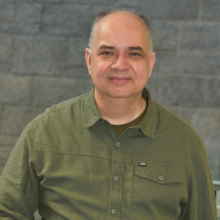Thomas Stroh, PhD

Thomas Stroh is interested in G protein-coupled receptors. Specifically, his research focuses on the mechanisms governing the availability of receptors at the cell surface of neurons and of neuroendocrine cells, that can determine their sensitivity to endogenous transmitters and neuropeptides and, by extension, to pharmacological agents acting at the same receptors as the endogenous messengers. Using the family of somatostatin receptors as a model system, which is composed of five receptor subtypes, he seeks to understand how the density of any given receptor subtype at the cell surface is regulated and how the different receptor subtypes interact in this process.
Stroh studies these phenomena both in vivo and in cell culture, using standard cell lines, which he transfects with combinations of recombinant receptors and accessory proteins involved in intracellular trafficking, as well as cells endogenously expressing somatostatin receptors. He applies a combination of biochemical, cell biological and neuroanatomical methods to these studies, placing a particular emphasis on the combination of light and electron microscopic approaches with receptor binding techniques to correlate anatomy with function. The goal of these studies is to better understand the mechanisms which regulate this plasticity in cellular sensitivity to transmitters, peptides, and drugs.
Bouchard, J.-F., Horn, K.E., Stroh, T., and Kennedy, T.E., Depolarization Recruits DCC to the Plasma Membrane of Embryonic Cortical Neurons and Enhances Axon Extension in Response to Netrin-1, J. Neurochem. 107 (2), 398-417 (2008)
Sharif, N., Gendron, L., Wowchuk, J., Sarret, P., Mazella, J., Beaudet, A., and Stroh, T., Co-expression of somatostatin receptor subtype 5 (sst5) affects internalization and trafficking of somatostatin receptor subtype 2 (sst2A). Endocrinology 148, 2095-2105 (2007)
Gendron, L., Esdaile, M.J., Mennicken, F., Pan, H., O’Donnell, D., Vincent, J.-P., Devi, L.A., Cahill, C.A., Stroh, T., and Beaudet, A., Morphine priming in rats with chronic inflammation reveals a dichotomy between antihyperalgesic and antinociceptive properties of deltorphin. Neuroscience 144, 263-274 (2007)
Stroh, T., Sarret, P., Tannenbaum, G.S., and Beaudet, A., Immunohistochemical distribution and subcellular localization of the somatostatin receptor subtype 1 (sst1) in the rat hypothalamus. Neurochem. Res. 31, 247-257 (2006)
Savdie, C., Fergusson, S.S.G., Vincent, J.-P., Beaudet, A., and Stroh, T., Cell-type-specific pathways of neurotensin endocytosis. Cell Tiss. Res. 324, 69-85 (2006)
Gendron, L., Lucido, A.L., Mennicken, F., O’Donnell, D., Vincent, J.-P., Stroh, T., and Beaudet, A., Morphine and pain-related stimuli enhance cell surface availability of somatic delta opioid receptors in rat dorsal root ganglia. J. Neurosci. 26, 953-962 (2006)
Sarret, P., Esdaile, M.J., Perron, A., Martinez, J., Stroh, T., and Beaudet, A., Potent spinal analgesia elicited through stimulation of NTS2 neurotensin receptors. J. Neurosci. 25, 8188-8196 (2005)
Wente, W., Stroh, T., Beaudet, A., Richter, D. and Kreienkamp, H.-J., Interactions with PDZ domain proteins PIST/GOPC and PDZ-K1 regulate intracellular sorting of the somatostatin receptor subtype 5. J. Biol. Chem. 280, 32419-32425 (2005)
Perron, A., Sarret, P., Stroh, T., and Beaudet, A., Identification and functional characterization of the 5-transmembrane domain variant isoform of the NTS2 neurotensin receptor in rat central nervous system. J. Biol. Chem. 280, 10219-10227 (2005)





